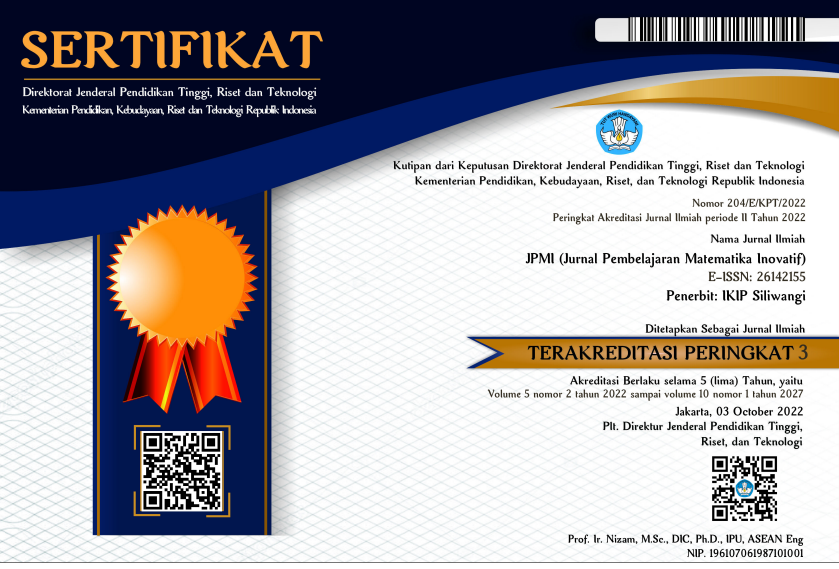E-LEARNING BERBASIS MOODLE SEBAGAI MEDIA PEMBELAJARAN MATEMATIKA DITINJAU DARI PEMAHAMAN MAHASISWA
DOI:
https://doi.org/10.22460/jpmi.v4i6.p%25pKeywords:
e-learning, moodle, understanding mathematicsAbstract
The purpose of this study is to determine the effectiveness of Moodle-based e-learning which is used as a learning medium in terms of student understanding. This type of research is quantitative quasi-experimental research with a one group pretest posttest design. The population of this study was 2nd-semester students. The sample of this research was 36 students who were taken based on cluster random sampling technique. This research instrument uses math test questions that can be accessed through e-learning. The data analysis techniques were normality test as a prerequisite test, test for the difference in average pretest and posttest, test for the increase in the pretest and posttest results (N-Gain), and finally the effect size test. The results showed that the pretest data were not normally distributed, while the posttest data were normally distributed so that nonparametric statistical tests were carried out. The nonparametric statistical test used is the Wilcoxon test where the results show a sig score. (0.00) <0.05, which means that there is a difference between the average pretest and posttest scores. Furthermore, the n-gain test was carried out with a score of 0.53 which was in the medium category. This means that the pretest and posttest scores have a moderate level of improvement. And the last test results with the effect size test with a score of d = 1.47 which is in the strong effect category. This means that Moodle-based e-learning has a strong effect on students' understanding of mathematical concepts.
References
Azwar, S. (2004). Metodologi Penelitian. Jakarta: Pustaka Pelajar.
Cohen, J. (1988). Statistical Power Analysis for the Behavioural Science (2nd Edition). In Statistical Power Anaylsis for the Behavioral Sciences. Routledge Academic.
Darmawan, D. (2014). Pengembangan E-LEARNING Teori dan Desain. In Remaja Rosdakarya. PT. Remaja Rosadakarya.
Fauzi, A., & Widjajanti, D. B. (2018). Self-regulated learning: The effect on student’s mathematics achievement. Journal of Physics: Conference Series, 1097(1). https://doi.org/10.1088/1742-6596/1097/1/012139
Fauzi, Asri, Rahmatih, A. N., Indraswati, D., & Husniati. (2020). Penalaran analogi mahasiswa PGSD dalam menyelesaikan masalah matematika berdasarkan gaya berpikir. AKSIOMA: Jurnal Matematika Dan Pendidikan Matematika, 11(2), 323–334.
Hidayati, P. I. (2016). Optimalisasi Pengembangan Blended Learning Berbasis Moodle untuk Matakuliah Mikrobiologi. Jurnal Inspirasi Pendidikan Universitas Kanjuruhan Malang, 6(2), 890–897.
Istiqomah, J. Y. N., & Indraini, E. (2021). Meta Analisis Efektivitas Model Pembelajaran Problem Based Learning Terhadap Kemampuan Berpikir Kritis Siswa SD. Jurnal Cendekia: Jurnal Pendidikan Matematika, 05(01), 670–681. https://jurnal.unibrah.ac.id/index.php/JIWP
Karwati, E. (2014). Pengaruh Pembelajaran Elektronik (E-Learning) terhadap Mutu Belajar Mahasiswa. Jurnal Penelitian Komunikasi, 17(1), 41–54. https://doi.org/10.20422/jpk.v17i1.5
Keban, P., & Taufik, T. (2017). E-LEARNING BAGI GURU-GURU DI MA NEGERI 1 GRESIK DAN SMA ASSA’ADAH GRESIK UNTUK MEWUJUDKAN KONSEP SEKOLAH BERBASIS TEKNOLOGI INFORMASI DAN KOMPUTER. Jurnal Layanan Masyarakat (Journal of Public Services), 5(2), 1–12. https://doi.org/10.20473/jlm.v1i1.2017.26-31
Khoir, H. M., Murtinugraha, R. E., & Musalamah, S. (2020). Pengembangan Media Pembelajaran E-Learning Berbasis Moodle Pada Mata Kuliah Metodologi Penelitian. Jurnal Pendidikan Teknik Sipil (JPenSil), 9(1), 54–60. https://doi.org/10.21009/jpensil.v9i1.13453
Lakens, D. (2013). Calculating and reporting effect sizes to facilitate cumulative science: A practical primer for t-tests and ANOVAs. Frontiers in Psychology, 4(NOV), 1–12. https://doi.org/10.3389/fpsyg.2013.00863
Nadziroh, F. (2017). Analisa efektifitas sistem pembelajaran berbasis e-learning. Jurnal Ilmu Komputer Dan Desain Komunikasi Visual (Jikdiskomvis), 2(1), 1–14.
Orcan, F. (2020). Parametric or Non-parametric: Skewness to Test Normality for Mean Comparison. International Journal of Assessment Tools in Education, 7(2), 236–246. https://doi.org/10.21449/ijate.656077
Purmadi, A., & Sa’di, K. (2021). Pengembangan Kelas Virtual Berbasis Moodle untuk Memfasilitasi Efektivitas Pembelajaran Siswa Di Sekolah Dasar. JINOTEP (Jurnal Inovasi Dan Teknologi Pembelajaran): Kajian Dan Riset Dalam Teknologi Pembelajaran, 8(1), 11–19. https://doi.org/10.17977/um031v8i12021p011
Rahmatih, A. N., Fauzi, A., & Ermiana, I. (2020). Hubungan Motivasi dan Kemandirian Belajar Mahasiswa Calon Guru Sekolah Dasar. Wahana Sekolah Dasar, 28(2), 76–83. https://doi.org/10.17977/um035v28i22020p076
Sanjaya, W. (2009). Strategi Pembelajaran Berorientasi Standar Proses Pendidikan. Bandung: Kencana.
Sundayana, R. (2016). Statistika Penelitian Pendidikan. Jakarta: Alfabeta.
Turrahma, A., Satyariza, E. N., & Ibrahim, A. (2018). Pemanfaatan E-Learning Berbasis Lcms Moodle Dalam Peningkatan Efisiensi Dan Efektivitas Serta Kualitas Media Pembelajaran Siswa Di Man Sakatiga. Jurnal Nasional Pendidikan Teknik Informatika (JANAPATI), 6(3), 327. https://doi.org/10.23887/janapati.v6i3.12672
Uno, H. B. (2011). Tekhnologi Komunikasi Dan Informasi Pembelajaran. Bumi Aksara.
Wicaksana, E. (2020). Efektifitas Pembelajaran Menggunakan Moodle Terhadap Motivasi Dan Minat Bakat Peserta Didik Di Tengah Pandemi Covid -19. EduTeach : Jurnal Edukasi Dan Teknologi Pembelajaran, 1(2), 117–124. https://doi.org/10.37859/eduteach.v1i2.1937
Yanah, P. A., Nyeneng, I. D. P., & Suana, W. (2018). Efektivitas Model Flipped Classroom pada Pembelajaran Fisika Ditinjau dari Self Efficacy dan Penguasaan Konsep Siswa. JIPFRI (Jurnal Inovasi Pendidikan Fisika Dan Riset Ilmiah), 2(2), 65–74. https://doi.org/10.30599/jipfri.v2i2.302

















